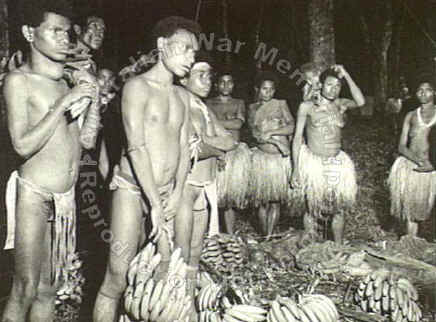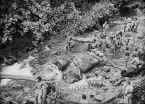 |
Owen
Stanley Ranges, New Guinea. C. 1942-09-01.
Wounded Australians being carried on stretchers out of forward battle
areas through a mountain stream by native bearers |
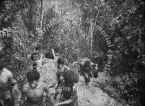 |
Eora Creek, Papua.
1942-08-30. Native bearers
(popularly known as Fuzzy Wuzzy Angels) carry a wounded Australian
soldier on a stretcher. They are moving up a steep hill track through
thick tropical jungle.
|
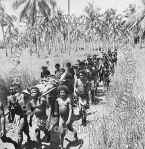 |
1942-12-05.
Buna, Papua. At an advanced
American dressing station. Wounded being brought in on stretchers along
a track through the kunai grass. The bearers are Papuan natives, fondly
known as Fuzzy Wuzzy Angels. |
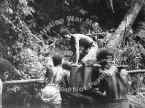 |
1942-08-06. Papua.
Native bearers (popularly known as Fuzzy Wuzzy Angels) carry heavy loads
of equipment and supplies for the Australian troops. One "boy"
usually carries about 50 lbs weight, and two "boys" can manage
about 70lbs.
|
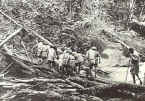 |
New
Guinea. C. 1942-09-02.
An indication of the primitive lines of communication and of the
difficulties encountered in the movement of troops is shown here. Native
porters (known as Fuzzy Wuzzy Angels) are carrying wounded Australian
soldiers on stretchers from the jungle battlefield through a mountain
stream to the hospital behind the lines, following a sharp clash with
Japanese forces. All Australians in New Guinea pay a high tribute to the
courage, endurance and comradeship of the New Guinea natives who are
playing a very important part in the allied efforts to drive the
Japanese from the country |
 |
Owen
Stanley Ranges, New Guinea. C. 1942-09-05.
Wounded
Australians being carried on stretchers out of forward battle areas into
a village by native bearers or porters (known as Fuzzy Wuzzy Angels). |
 |
Soputa,
Papua, 1942-11. Informal outdoors
portrait of a native Papuan 'boss boy' at the Main Dressing Station
(MDS) of the 2/4th Field Ambulance. Boss boys were in charge of native
stretcher-bearer teams made up of eight members. Called colloquially 'Fuzzy
Wuzzy Angels', both boss boys and stretcher-bearers were employed by the
Australian New Guinea Administrative Unit (ANGAU). (Donor A. Hobson) |
 |
Uberi,
Papua, c. 1942-10. A group of
native Papuan carriers is about to evacuate a wounded Australian soldier
on a stretcher along the Kokoda Trail from Uberi to the start of the
motor road at Owens' Corner. The stretcher is slung below a single
carrying bar supported at each end by one of the carriers. Known
colloquially as 'Fuzzy Wuzzy Angels', the carriers work in teams of
eight under the supervision of a native 'boss boy' and are employed by
the Australian New Guinea Administrative Unit (ANGAU). Standing and
looking on at rear (centre, right) is Corporal Rowley, a member of the
2/4th Field Ambulance, while a sign (left) points to the unit latrine.
In the background, standing beside a native hut is a large pile of boxes
containing ammunition, a state of affairs that probably breaches
international covenants forbidding the presence of armaments in a
designated Red Cross or medical area. (Donor A. Watson) |
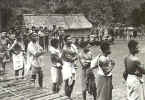 |
Papua,
New Guinea. 1942-08. One of the
major problems of the campaign in New Guinea is the transport of
supplies and native carriers have to be employed to traverse the narrow
paths through the valleys and along the ridges in the Kokoda area. Here
native carriers are seen lined up at a control point waiting for their
loads. |
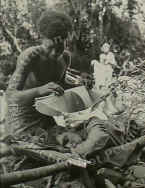 |
New
Guinea. 3 November 1943. A Fuzzy
Wuzzy native uses a banana leaf to protect an Australian soldier on a
stretcher from the rays of the sun at a resting point in a forward area
in the Upper Ramu Valley advance. |
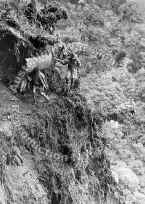 |
Bulldog
Road, New Guinea, 1943-07-18.
Natives carrying compressor parts, negotiate a narrow and dangerous
ledge about a mile south of Eggleston's Gap. This ledge varies from
18" to 2 feet wide.
Note the dangerous drop that one
misplaced step would take you over.
Note the back to front slouch hat on
one bearer |
 |
Mubo,
New Guinea, 1943-07-27. "The
village Square" 2/5th battalion, quartermaster's store where goods
are checked for despatch by native carriers to the front line at Mount
Tambu and Goodview. Photograph shows Australian troops briefing a line
of native carriers. Shown are 1-8:- VX43880 corporal AE Tierney; NX90799
Private AF Lester; VX5215 Private A. S. Roberts; VX4246 Lieutenant D. L.
Whitaker; VX38960 Sergeant J. M. Taylor; VX3681 Sergeant J. D. Baxter;
V504081 Warrant Officer E. Britten; Sergeant l. Barker. |

